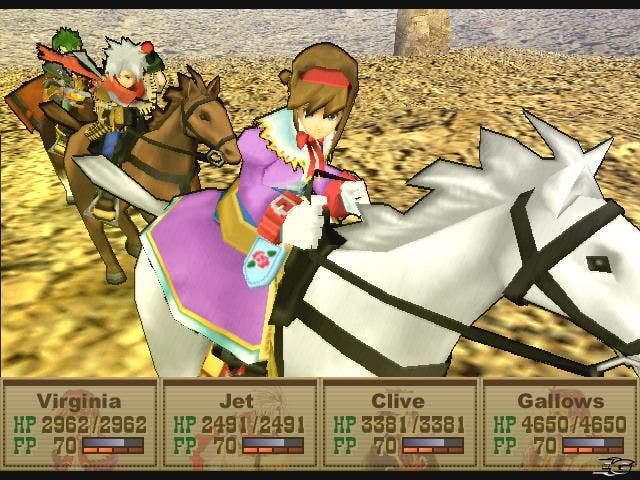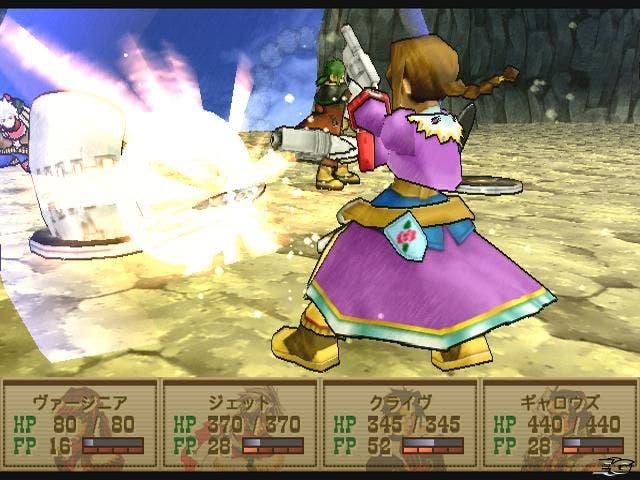Wild Arms 3
Rob challenges the definition of deadline once again with his take on Ubi's RPG
Despite the heritage of the original PlayStation as the platform to own for the Japanese RPG fan, its successor is surprisingly under-stocked in this department - in Europe, at least. Aside from the fantastic Final Fantasy X, European gamers really only have the likes of Dark Cloud, almost-an-RPG Square-Disney collaboration Kingdom Hearts and the tragically under-rated Shadow Hearts to choose from - slim pickings indeed. Of course, this picture is much better Stateside, where the likes of Suikoden III, .hack and Xenosaga have been released, and the lucky Japanese just got their mitts on Final Fantasy X-2 and Star Ocean 3: Till the End of Time, but for European gamers without the ability to play imports (or indeed speak Japanese), such turn-based delights are still a long way off.
Wild Arms 3, the successor to a pair of little-known but quite well respected PlayStation RPGs, aims to fill that gap in the diet of the ardent Japanese RPG fan. Like many other RPG series, Wild Arms starts each game with a fresh slate - although there are hints that this game may be set in the same world as its predecessor, you don't need to have played either previous game in order to get stuck into WA3. The slightly oblique references to events in earlier games are few and far between, and you can happily sail through the game without ever noticing them.
Wild Arms' setting is very different to the usual swords 'n sorcery (or technology 'n magic) backdrop employed by most RPGs. Unusually, the theme of the series is modelled heavily on the Old West, and from the designs of the locations to the background music, it's clear that the team has watched rather a lot of Westerns. Of course, this is all tempered with the usual Japanese stylistic touches - the characters may sport spurs, six-shooters and Stetsons, but they're anime designs through and through. (In fact, there is a Wild Arms anime TV series, although it doesn't feature any of the characters from the game.)

Cel-shaded cowboys
Graphically, Wild Arms 3 isn't exactly the most impressive game to grace the PS2. The game's characters are cel-shaded, which takes a little bit of getting used to but works quite well; however the environments and world map are downright ugly in most places, and indeed some of the graphics you'll see here wouldn't look out of place on the original PlayStation. Overall, however, the graphics are more than passable, if a bit workmanlike; what's of more concern is the fact that the team hasn't gone to any great lengths to create a wide range of interesting creatures to fight. In fact, most areas in the game seem to have only two creatures, with random battles popping up a mix and match selection of the two - not exactly a wide or interesting menagerie.
Ah yes, random battles. Wild Arms 3 is nothing if not a very traditional RPG, and the random battles are certainly here in force - although thankfully the developers have made them at least partially optional. While strolling around dungeons or on the world map, before a random battle occurs a small exclamation mark will pop up over your head, and it's possible to avoid taking part in the battle by pressing a button at this point. This costs you points from an onscreen gauge, however, so you can't keep avoiding random battles forever; but as your characters progress through the game, you'll gain the ability to avoid battles with very weak monsters without costing any points, so you can walk around areas with weak creatures without constantly being annoyed with stupidly easy random battles. This is a nice touch, and will certainly be welcomed by the legions of ardent random battle haters.
Otherwise the game is roughly as you'd expect from a competent Japanese RPG. Each character has physical attacks (shooting the enemy with a gun, called an ARM) and magic (Arcana) attacks, monsters come with weaknesses to certain types of attacks... You all know the story. This immensely rigid conformity to the stereotypical RPG game design can grate a little - not helped by a very clichéd story about a world threatened by a great power in the aftermath of a war against demons, four drifters who come together to save it and, of course, the obligatory grouchy boy with no knowledge of his past. You're introduced to each character in turn in four "solo play" sections at the start of the game, which serve as an entertaining prologue to the main story.

Unforgiven?
This is all made worse by the single most annoying aspect of the game - namely the need to search for locations on the world map using a type of radar. Locations don't show up until you're meant to know about them, and what this generally means is that after each plot segment you'll be given the vaguest of details about the next place you're meant to go, and sent off to wander around the map aimlessly for ten minutes hammering the square button in an attempt to find the next village or dungeon. Why the developers felt the urge to include this is beyond us; it completely breaks the flow of play and is by far the single worst element of the game.
Thankfully, once you get into the dungeons, things lighten up considerably. Although the battles are turn-based, the game has quite an interesting line in dungeon puzzles, with each character in your party having "tools" which can be applied to solve puzzles and progress through dungeons. To begin with, you get tools such as a boomerang (for hitting switches a long way off) and a fire spell (which can light torches or melt ice), and some of the chaining puzzles later in the game are really quite difficult - but an entertaining break from standard RPG fare.
For all its flaws and its hugely traditional approach to the genre, Wild Arms 3 has a lot to recommend it to any Japanese RPG fan. The music and overall presentation of the game is superb, and the combination of action RPG-style dungeons with competent, turn-based battles is a very entertaining mixture. The game also has the occasional surprise to spring - we were enthralled the first time we found horses to gallop around the plains on, and were then treated to a battle on horseback, complete with angry enemy monsters running alongside our heroes. The traditional cel animation "opening sequence", which plays each time you load a game, is a nice touch as well - and we're very taken with the ability to save your game at any point thanks to an unusual save system which puts fixed save points only in villages, and elsewhere requires that you use "gimel coins", which are effectively portable single-use save points.

A Fistful of Dollars
Wild Arms 3 isn't for everyone by any means. If you don't like Japanese RPGs in general, you probably don't even want to look here; and if you're a fan of recent Final Fantasies but find older Japanese RPGs too slow-moving and all alike, look elsewhere (possibly at Shadow Hearts). However, if you're prepared to overlook quite a few flaws, Wild Arms 3 is a charming and entertaining Japanese RPG which adheres to the conventions of the genre far too much for its own good, but will still provide many, many hours of entertainment.

